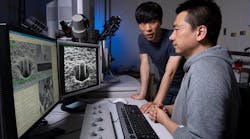Purdue researchers discovered that some ceramics’ brittleness can be overcome as they sustain heavy loads, which could lead to more resilient structures such as aircraft engine blade coatings and dental implants.
Although ceramics are inherently strong, most fracture suddenly when just slightly strained under a load unless exposed to high temperatures. Structural ceramic components require high temperatures to form in the first place through a lengthy process called sintering, in which a powdered material coalesces into a solid mass.
These issues present a challenge for ceramic coatings of metal engine blades intended to protect metal cores from a range of operational temperatures. But the researchers found out that applying an electric field to yttria-stabilized zirconia (YSZ), a typical thermal barrier ceramic, makes the material almost as plastic, or easily reshaped, as metal at room temperature. Engineers could also see cracks sooner since they start to slowly form at a moderate temperature as opposed to higher temperatures, giving them time to rescue a structure. for the usage of ceramics.
Applying an electric field to ceramics while they form gives them the metal-like characteristics needed for sustaining heavy loads without collapsing. (Purdue University image/Jaehun Cho)
Recent studies have shown that applying an electric field, or “flash,” significantly accelerates the sintering process that forms YSZ and other ceramics, and at much lower furnace temperatures than conventional sintering. Flash-sintered ceramics also have little porosity, which makes them denser and therefore easier to deform.
“YSZ is a very typical thermal barrier coating—it basically protects a metal core from heat,” says Haiyan Wang, an engineering professor at Purdue. “But it tends to suffer from a lot of fractures when an engine heats up and cools down due to residual stresses.”
What gives metals their ability to resist fractures and change shape easily is the presence of “defects,” or dislocations, i.e., extra planes of atoms that shuffle during deformation to make a material simply deform rather than break under a load. These dislocations move under compression or tension so the material doesn’t fail. Ceramics normally don’t form dislocations unless deformed at very high temperatures. Flash-sintering them, however, introduces these dislocations and creates a smaller grain size in the resulting material. Smaller grains, such as nanocrystalline grains, may slide as the ceramic material deforms, helping the ceramics deform more easily.
Pre-existing dislocations and small grain sizes let flash-sintered YSZ sample thinner than human hair to become increasingly plastic between room temperature and 600°C when compressed, with cracks starting to slowly spread at 400° as opposed to conventionally sintered YSZ that requires 800° and higher to plastically deform.
Improved plasticity means more stability during operation at relatively low temperatures. The sample could also withstand almost as much compression strain as some metals do before cracks appeared. Metals can be compressed to 10 or 20% strain, but ceramics often fracture into pieces if compressed to less than 2 to 3 % strain. The Purdue team showed that flash-sintered ceramics can be compressed to 7 to 10 percent without catastrophic fracture. Even when the sample began to crack, the cracks formed slowly and did not result in complete collapse as would typically happen with conventional ceramics. The next steps will be using these principles to design even more resilient ceramic materials.


